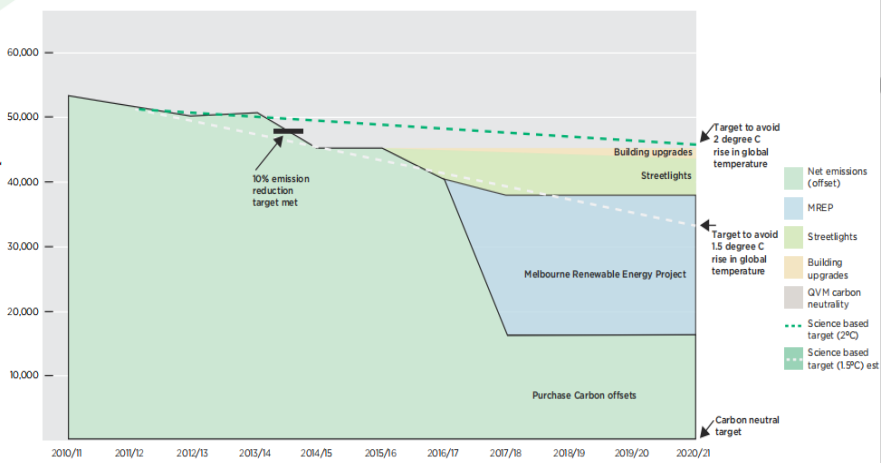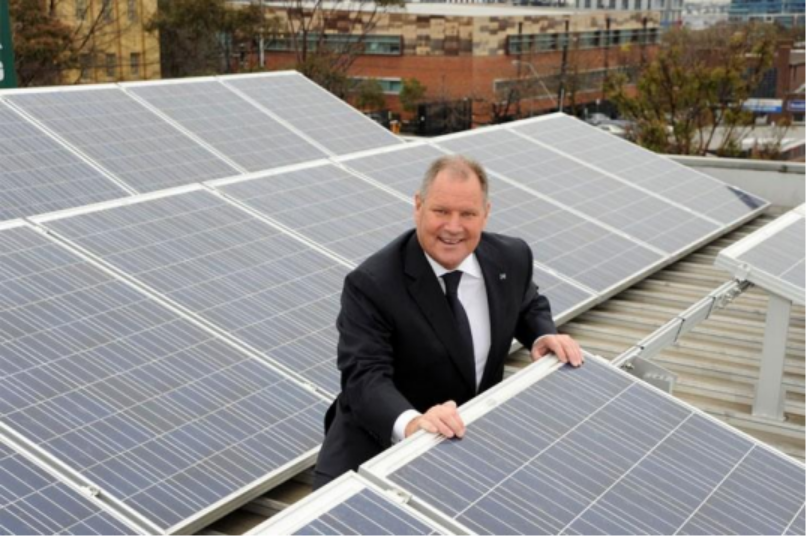Part A: The Context of the Chosen Case Study
Introduction
In the past decade, the world is extremely cautious about the environmental problem of global warming. Last year, Australia had been suffering the largest bush fires ever in the country’s history. Record-breaking temperatures have fueled huge fires and engulfed over 11 million hectares of wetland, bush and forests(Weber et al., 2019, p99). Therefore, all the cities in the country should undertake joint effort in countering the extreme weather condition. In Melbourne, temperatures and heatwaves are forecast to intensify. The climate departure is also reported to be consistently hotter than any in the past 150 years. Under such context, Melbourne is expected to contribute significantly to the reduction of carbon emission in order to prevent global warming. Carbon dioxide emitted by human beings is the main cause of global warming. According to the report released by CSIRO, temperature in Melbourne has risen by 0.9 degrees since 1910(Alory, Wijffels&Meyers, 2007, p2). Elevated temperatures pose a potential threat to public health and natural environment. For instance, local residents are suffering from the heat stress. Water loss and shortage are even threatening the lives of animals in their habitats. Heatwaves also result in reduced work productivity. In the next century, labor capacity is predicted by 40% as workers will experience climatological heat stress. Besides, heatwaves will also adversely impact Melbourne’s urban eco-system and wildlife. It is reported that flying fox, birds and fauna are strongly affected by the Queensland heat waves.
As early as in 2003, the city of Melbourne set a goal to become carbon neutral by the end of 2020. The city also decided to have a zero net carbon emission by 2020 across the municipality. Being carbon neutral means that the overall Greenhouse gases(GHGs) emission associated with an organization or city’s operation should be equal to zero. The municipal government also discovered that major sources of GHGs emission are from the local companies and organizations. By the end of 2008, Melbourne managed to reduce 5,359t of carbon, nearly 10% as compared in 2003. In order to enhance the effectiveness of carbon emission reduction strategies, the Australian Government developed the National Carbon Offset Standard (NCOS) and Carbon Neutral Program for local companies and organizations. Only two years later, Melbourne city achieved carbon neutral certification for the city’s operations and activities for the NCOS baseline year 11-12. On each subsequent year, Melbourne successfully maintain the certification of being carbon neutral. In 2016, the Australian government signed the Paris Climate Change Agreement. According to the agreement, member countries should limit the global temperature rise within 2oC. The city of Melbourne calculated science-based emission reduction to be 45,242t annually to achieve carbon neutrality. However, it is still difficult for the city to accomplish the goal of zero emission and carbon neutrality by the end of 2020.
Part B: Make the city of Melbourne more sustainable
Science-based target
Like the aforementioned, each city including Melbourne in Australia has to make their contribution to reduce carbon emission to avoid 1.5 to 2oC rise in average global temperature by 2050 according to the Paris Agreement(Rogelj et al., 2016, p631). A science-based target is developed by the Municipal government of Melbourne. Each year, Melbourne city has to reduce the carbon emission by 1.5% or 5,738 tonnes of carbon dioxide to avoid 2oC temperature. However, in order to prevent 1.5oC rise, the city of Melbourne has to reduce emissions by nearly 4.5% or 17,524 tonnes of carbon dioxide equivalent. The green and white dotted line represents the science-based target to avoid 2oC and 1.5oC respectively. In order to tangibly reduce the temperature rise and carbon emission, more measures should be undertaken in the whole emission reduction plan.

Source Credit:The Municipal Government of Melbourne
Fig 1: Emission Reduction Pathway from 2010 to 2021
Celebrate Melbourne without the Emissions:
In the past five years, Melbourne’s citizens and local communities have done an excellent job in reducing carbon emission. More than 200,000 tonnes of carbon dioxide equivalent have been offset. Even though people in Melbourne celebrates different cultures and festivals, majority of the decoration materials, lights and facilities provided by the municipal government is made carbon neutral. The local government will continue to reduce the carbon emissions from events and celebration ceremonies. As a matter of fact, people in Melbourne do celebrate different festivals. For instance, annual festivals such as Melbourne Spring Fashion Week, New Year’s Eve, Melbourne Music Week, Moomba, Christmas Day, etc, each year will attract countless visitors either from Australia or other parts of the world to the city. As such, the municipal government has to effectively calculate the emissions from the above-mentioned events. The estimated emission of carbon dioxide in festivals and public events is now about 3,768 tonnes. In order to continue to offset the emissions, Melbourne’s government should work with community event planners, event partners and sponsors to reduce and offset carbon emission from catering, transport, venues and waste. For instance, in the transport area, cycling, walking and public transport systems should be promoted to event patrons. Besides, Melbourne’s government should also work with even suppliers to reduce packing and increase the carbon-neutral products. In order to achieve the target of carbon-neutral, all the carbon dioxide equivalents or carbon emissions should be removed.
Zero Carbon for Melbourne’s buildings:
Another critical part is to ensure zero carbon emission for Melbourne’s major buildings. As shown in Fig 2, the emissions from the city of Melbourne’s large buildings can be illustrated very clearly. Carlton Baths releases almost 30% of carbon dioxide equivalents and followed by Kensington pool, 18%. So far, there are more than 40 community buildings in Melbourne which are recognized as large users of energy(Melbourne Government, 2020, p1. The community buildings may include swimming pools, recreation centers, health care centers, libraries, etc. Besides, smaller buildings such as newspaper stands, street furniture and public toilet are equal likely in consuming energy but it is rather challenging to conduct a systematic approach to reduce such emissions. Hence, in order to reduce the carbon emission in major buildings, three approaches should be done accordingly,
Ø Right Decisions: Municipal government of Melbourne should advise large and small buildings to build energy-efficient equipment and promote renewable energy so as to construct more green buildings or zero-emission buildings. The total carbon emission in the Melbourne’s building sector should be reduced by at least 5,000 tones each year in order to meet the carbon neutrality target(Kang et al, 2010, p39).
Ø Right Information: Asset management plans and specification for each building should be inspected very carefully in order to reduce carbon dioxide emission.
Ø Right Data and Processes: Energy intelligence system should also be introduced(Kolokotsa et al., 2011, p3067). For instance, if a particular building is exceeding the requirement for carbon dioxide emission, it can be discovered immediately. Government officials and approach the building manager to discuss about how to reduce energy consumption and carbon emission accordingly.

Source Credit:Municipal Government of Melbourne
Fig 2: Emissions from City of Melbourne’s large buildings
Promoting Carbon-neutral Goods and Services:
According to Bocken et al.,(2011, p279), GHG emissions associated with goods and services are about 5,600 tones or 13% of the total annual emission. The report further points out that the carbon emissions are more produced by outsourced services instead of local products supply. Each year, the municipal government requests products and services suppliers to calculate their own carbon emissions clearly in the process of shipping, energy consumption, waste, etc, when completing a business contract. In order to reduce the carbon emission across the supply chain in Melbourne, suppliers are advised to produce carbon-neutral products and services to meet the environmental sustainability goal. Besides, it is also advisable for the municipal government to measure the impact across the decision-making life-cycle in purchasing and procurement. Carbon-neutral products and services can be promoted and monitored in contract management or through key performance indicators(Elhedhli&Merrick, 2012, p370). In order to enhance the overall effectiveness of carbon emissions reduction and sustainability strategy, the municipal government is advised to,
Ø Continue to measure and report emissions from suppliers including sub-contractors(Benjaafar et al., 2012, p99). All the major stakeholders in the supply chain should also be inspected with respect to carbon dioxide emissions.
Ø Contract managers should be trained very well in regards to evaluation, negotiation and management of carbon-neutral products and services.
Ø Organize training workshop to encourage companies and organizations to reduce carbon emission or produce carbon-neutral products.
Ø Increase market demand for carbon-neutral products and services through raising green awareness among the common public(Sundarakani et al, 2010,p43).
Part C: Renewable Energy
Solar energy so far is a highly clean and efficient renewable energy source which can potentially replace traditional energy types such as fossil fuels in generating electricity. In order to help Melbourne meet the environmental goal of carbon emission reduction, renewable energy such as Solar energy should be introduced into the picture. First, solar energy is naturally abundant and readily available. In the natural world, the average daily solar radiation is about 1600 kWh/m2. originally solar energy is criticized for poor efficiency. However, due to rapid technological development, solar energy efficiency can effectively reach 19%(Schultz et al., 2008, p317). it means that people can finally convert very much solar energy into electricity. Solar energy is clean and generate no GHGs. Solar panels can be installed widely regardless of locations in Melbourne. Most importantly, solar panels usually encounters very low maintenance fees because they have a life span exceeding 20 or even 30 years. Solar panels can satisfy both small scale and large scale installation in Melbourne. According to the research conducted by Monash University, researchers discover that Positive Energy Places manage to generate nearly 21% of renewable energy than energy consumption in producing electric vehicles and motors (Fig 3)(The Municipal Government of Melbourne, 2020, p2).

Source Credit: Melbourne.vic.gov.au/solar
Fig 3: Lord Mayor Robert Doyle visiting the solar installation in Positive Energy Places in Melbourne
Renewable or green energy should be considered in replacing fossil fuels in energy consumption. However, 100% renewable energy does not really mean zero carbon emission. Renewable energy as compared with traditional energy types have the advantage of low carbon footprint. So far in the energy market, there are many competing renewable energy sources such as nuclear energy and wind energy. Different energy resource has slightly different carbn footprint. The emission footprint of nuclear energy is about 4g of carbon dioxide equivalent (gCO2e/kWh). Solar has a carbon footprint of 6 gCO2e/kWh and wind is 4gCO2e/kWh(Perry, Klemeš&Bulatov, 2008, p1489). However, among all the three kinds of renewable energy, Even though solar energy has higher footprint than the other two renewable energy. It should be noted that nuclear energy is highly dangerous. Wind energy as compared with solar energy is also less stable. The electricity generation capacity also cannot be compared with solar energy.
One possible solar energy strategy in reducing carbon emissions can be shown in Table 1,
Location |
Melbourne |
System Size |
24KW |
Estimated Annual production |
25 MWh |
CO2 emission reduction |
400 tonnes |
Solar Inverter: Sun Boy |
Ø 1 X three phase 10kW Peak Ø 2X Single phase 5kW peak Ø 1X Single phase 3.6kW peak |
Solar panels |
Ø ZnShine: 810 X 1580mm 190W Ø Aeol: 990 X 1660mm 215W |
Mounting System: |
Clipped to aluminium channels |
Pay Back Period: |
de Wild-Scholten, 2013, 297). |
Reference
Alory, G., Wijffels, S., & Meyers, G. (2007). Observed temperature trends in the Indian Ocean over 1960–1999 and associated mechanisms. Geophysical Research Letters,34(2).
Bocken, N. M. P., Allwood, J. M., Willey, A. R., & King, J. M. H. (2011). Development of an eco-ideation tool to identify stepwise greenhouse gas emissions reduction options for consumer goods. Journal of Cleaner Production, 19(12), 1279-1287.
Benjaafar, S., Li, Y., & Daskin, M. (2012). Carbon footprint and the management of supply chains: Insights from simple models. IEEE transactions on automation science and engineering, 10(1), 99-116.
de Wild-,Scholten, M. M. (2013). Energy payback time and carbon footprint of commercial photovoltaic systems. Solar Energy Materials and Solar Cells, 119, 296-305.
Elhedhli, S., & Merrick, R. (2012). Green supply chain network design to reduce carbon emissions. Transportation Research Part D: Transport and Environment, 17(5), 370-379.
Kang, H. J., Kang, S. Y., Park, J. C., & Rhee, E. G. (2010). A study on the design process of zero emission buildings.Journal of the Korean Solar Energy Society, 30(2), 39-45.
Kolokotsa, D. E. K. D., Rovas, D., Kosmatopoulos, E., & Kalaitzakis, K. (2011). A roadmap towards intelligent net zero-and positive-energy buildings. Solar Energy, 85(12), 3067-3084.
Perry, S., Klemeš, J., & Bulatov, I. (2008). Integrating waste and renewable energy to reduce the carbon footprint of locally integrated energy sectors. Energy, 33(10), 1489-1497.
Rogelj, J., Den Elzen, M., Höhne, N., Fransen, T., Fekete, H., Winkler, H.,& Meinshausen, M. (2016). Paris Agreement climate proposals need a boost to keep warming well below 2 C. Nature, 534(7609), 631-639.
Schultz, O., Mette, A., Hermle, M., & Glunz, S. W. (2008). Thermal oxidation for crystalline silicon solar cells exceeding 19% efficiency applying industrially feasible process technology. Progress in Photovoltaics: Research and Applications, 16(4), 317-324.
Sundarakani, B., De Souza, R., Goh, M., Wagner, S. M., & Manikandan, S. (2010). Modeling carbon footprints across the supply chain. International Journal of Production Economics,128(1), 43-50.
The Municipal Government of Melbourne (2020). SOLAR CASE STUDY: POSITIVE ENERGY PLACES. Access on March 15, 2020. [Online]: https://www.melbourne.vic.gov.au/
SiteCollectionDocuments/case-study-positive-energy.pdf
Weber, D., Moskwa, E., Robinson, G. M., Bardsley, D. K., Arnold, J., & Davenport, M. A. (2019). Are we ready for bushfire? Perceptions of residents, landowners and fire authorities on Lower Eyre Peninsula, South Australia.Geoforum, 107, 99-112.